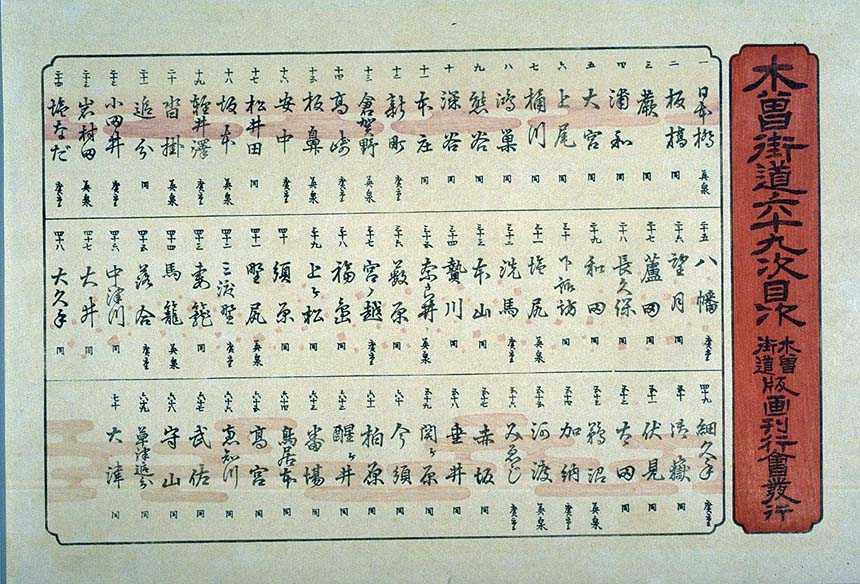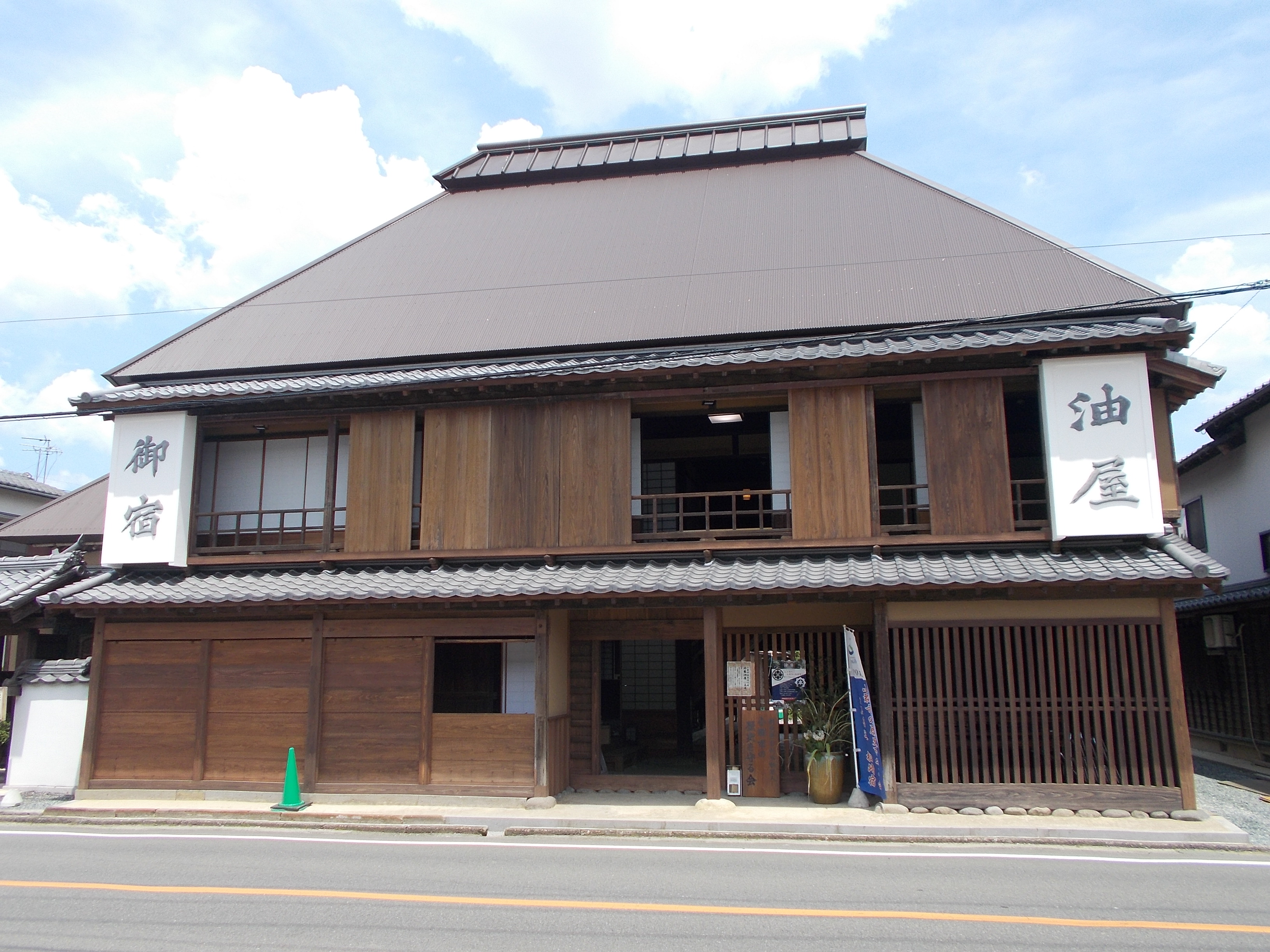|
Moriyama-juku
260px, Uno house museum in Moriyama-juku was the sixty-seventh of the sixty-nine stations of the Nakasendō highway connecting Edo with Kyoto in Edo period Japan. It was located in the present-day city of Moriyama, Shiga Prefecture, Japan. History Moriyama-juku was one of the original staging points on the ancient Tōsandō highway connecting the capital of Heian-kyō with the provinces of eastern Japan from the end of the Nara period onwards. Its name means "protecting mountain", and refers to Mount Hiei which contains the temple of Enryaku-ji, the head temple of the Tendai sect.Sixty-nine Stations of the Kiso Kaidō'' series was the fifty-second of the fifty-three stations of the Tōkaidō as well as the sixty-eighth of the sixty-nine stations of the Nakasendō. ... Notes References * * * * External links Hiroshige Kiso-Kaido series [...More Info...] [...Related Items...] OR: [Wikipedia] [Google] [Baidu] |
Moriyama, Shiga
270px, Lake Biwa from Moriyama is a city located in Shiga Prefecture, Japan. , the city had an estimated population of 85,485 in 34,366 households and a population density of 1533.63 persons per km2. The total area of the city is . Geography Moriyama is located on the south side of the alluvial fan where the Yasu River flowing from the Suzuka Mountains enters into Lake Biwa. The land is generally flat, and as with other coastal areas of Lake Biwa, it is occasionally subject to flooding of rivers and rising water levels in Lake Biwa. Neighboring municipalities Shiga Prefecture * Kusatsu * Otsu (By Lake Biwa Bridge) * Rittō * Yasu Climate Moriyama has a Humid subtropical climate (Köppen ''Cfa'') characterized by warm summers and cool winters with light to no snowfall. The average annual temperature in Moriyama is 16.4 °C. The average annual rainfall is 1603.5 mm with July as the wettest month. The temperatures are highest on average in August, at around 29.9 ° ... [...More Info...] [...Related Items...] OR: [Wikipedia] [Google] [Baidu] |
Kusatsu-juku
260px, The Sixty-nine Stations of the Kiso Kaidō">Sixty-nine Stations of the Kiso Kaidō'' series was the fifty-second of the fifty-three stations of the Tōkaidō as well as the sixty-eighth of the sixty-nine stations of the Nakasendō. It is located in the downtown area of the present-day city of Kusatsu, Shiga Prefecture, Japan. History Kusatsu has been a transportation hub for east–west travel on the ancient Tōsandō and Tōkaidō highways connecting the capital of Heian-kyō with the provinces of eastern Japan from the end of the Nara period onwards. During the Muromachi period, it developed as a relay point between Kyoto and the Ise Grand Shrines. In 1422, when Shogun Ashikaga Yoshimochi made a pilgrimage to Ise, he built a palace, the "Kusatsu Goshō" in this location. Around 1568, Oda Nobunaga forced Ashikaga Yoshiaki to cede the Kusatsu area, which he viewed as strategically critical to controlling the approaches to Kyoto. Nobunaga made extensive road repairs ... [...More Info...] [...Related Items...] OR: [Wikipedia] [Google] [Baidu] |
Chōsenjin Kaidō
The was a travel route during the Edo period in Ōmi Province, Japan. It received its name because it was used about 12 times by representatives of the Joseon (朝鮮) Dynasty in modern-day Korea during the Joseon missions to Japan. It was also called the Hikone Road (彦根道 ''Hikone-michi''), the Kyō Road (京道 ''Kyō-michi'') and the Hachiman Road (八幡道 ''Hachiman-michi''). It was originally built by Oda Nobunaga to join Azuchi Castle to Kyoto. After the Battle of Sekigahara, Tokugawa Ieyasu used it for going to Kyoto, so it was considered an auspicious road. It served as a sub-route of the Nakasendō, connecting Toriimoto-juku with Yasu village (between Musa-juku and Moriyama-juku). At , the route only skipped over three other post stations. Staying closer to Lake Biwa, the route went through the present day municipalities of Hikone, Azuchi, Ōmihachiman and Yasu in Shiga Prefecture is a landlocked prefecture of Japan in the Kansai region of Honshu. Shiga Pr ... [...More Info...] [...Related Items...] OR: [Wikipedia] [Google] [Baidu] |
The Sixty-nine Stations Of The Kiso Kaidō
The or ''Sixty-nine Stations of the Kiso Road'', is a series of ''ukiyo-e'' works created by Utagawa Hiroshige and Keisai Eisen. There are 71 total prints in the series (one for each of the 69 shukuba, post stations and Nihonbashi; Nakatsugawa-juku has two prints). The common name for the Kisokaidō is "Nakasendō" so the series is sometimes referred to as the ''Sixty-nine Stations of the Nakasendō''. It is a follow-up to Hiroshige's ''The Fifty-three Stations of the Tōkaidō'' and he produced 47 of the prints, with Eisen being responsible for the rest.Hiroshige - Kisokaido www.hiroshige.org.uk. Accessed November 1, 2017. The series was published by Iseya Rihei (Kinjudō) from .Forrer The Nakasendō The Nakasendō was one of the Edo Five Routes, Five Routes con ...[...More Info...] [...Related Items...] OR: [Wikipedia] [Google] [Baidu] |
Musa-juku
file:Nakasendo marker 2.jpg, A marker giving the distance to Musa-juku was the sixty-sixth of the 69 Stations of the Nakasendō, sixty-nine stations of the Nakasendō highway connecting Edo with Kyoto in Edo period Japan. It was located in the present-day city of Ōmihachiman, Shiga Prefecture, Japan. Other ''kanji'' used to write "Musa" included 牟佐 and 身狭, but 武佐 became the official ''kanji'' in the Edo period. History Musa-juku was one of the original staging points on the ancient Tōsandō highway connecting the capital of Heian-kyō with the provinces of eastern Japan from the end of the Nara period onwards. During the Sengoku period, the nearby ''jōkamachi'' of Ōmihachiman was developed by Toyotomi Hidetsugu, and many traveling merchants () relocated to this area from the ruins of Azuchi Castle. A road from Musa-juku extended towards Ise Province via Eigen-ji temple and the town of Yōkaichi, Shiga, Yōkaichi, which was used by the ''Ōmi shōnin'' for trans ... [...More Info...] [...Related Items...] OR: [Wikipedia] [Google] [Baidu] |
Sankin-kōtai
''Sankin-kōtai'' (, now commonly written as ) was a policy of the Tokugawa shogunate during most of the Edo period, created to control the daimyo, the feudal lords of Japan, politically, and to keep them from attempting to overthrow the regime. It required most daimyo to alternate between living in their domain and in the shogunate's capital, Edo, every year. This made the daimyo subject to constant surveillance from the shogunate. This also forced the daimyo to have residences in both their domain and Edo. The cost of maintaining several lavish residences as well as the journeys to and from Edo was a constant drain on the finances of the daimyo, which greatly increased the shogunate's control over them and kept them militarily weak. The daimyo were also required to keep their wife and children in Edo permanently to act as hostages. History Toyotomi Hideyoshi had earlier established a similar practice of requiring his feudal lords to keep their wives and heirs at Osaka Cas ... [...More Info...] [...Related Items...] OR: [Wikipedia] [Google] [Baidu] |
Oda Nobunaga
was a Japanese ''daimyō'' and one of the leading figures of the Sengoku period, Sengoku and Azuchi-Momoyama periods. He was the and regarded as the first "Great Unifier" of Japan. He is sometimes referred as the "Demon Daimyō" and "Demon King of the Sixth Heaven". Nobunaga was an influential figure in Japanese history and is regarded as one of the three great unifiers of Japan, along with his Affinity (medieval), retainers, Toyotomi Hideyoshi and Tokugawa Ieyasu. Nobunaga paved the way for the successful reigns of Hideyoshi and Ieyasu by consolidating power, as head of the very powerful Oda clan, through a series of wars against other ''daimyō'' beginning in the 1560s. The period when Nobunaga and Hideyoshi were in power is called the Azuchi–Momoyama period. The name "Azuchi–Momoyama" comes from the fact that Nobunaga's castle, Azuchi Castle, was located in Azuchi, Shiga; while Fushimi Castle, where Hideyoshi lived after his retirement, was located in Momoyama. Nob ... [...More Info...] [...Related Items...] OR: [Wikipedia] [Google] [Baidu] |
Toyotomi Hideyoshi
, otherwise known as and , was a Japanese samurai and ''daimyō'' (feudal lord) of the late Sengoku period, Sengoku and Azuchi-Momoyama periods and regarded as the second "Great Unifier" of Japan.Richard Holmes, The World Atlas of Warfare: Military Innovations that Changed the Course of History, Viking Press 1988. p. 68. Although he came from a peasant background, his immense power earned him the rank and title of and , the highest official position and title in the nobility class. He was the first person in history to become a ''Kampaku'' who was not born a noble. He then passed the position and title of ''Kampaku'' to his nephew, Toyotomi Hidetsugu. He remained in power as , the title of retired ''Kampaku'', until his death. It is believed, but not certain, that the reason he refused or could not obtain the title of , the leader of the warrior class, was because he was of peasant origin. Hideyoshi rose from a peasant background as a Affinity (medieval), retainer of the pr ... [...More Info...] [...Related Items...] OR: [Wikipedia] [Google] [Baidu] |
Tokugawa Shogunate
The Tokugawa shogunate, also known as the was the military government of Japan during the Edo period from 1603 to 1868. The Tokugawa shogunate was established by Tokugawa Ieyasu after victory at the Battle of Sekigahara, ending the civil wars of the Sengoku period following the collapse of the Ashikaga shogunate. Ieyasu became the ''shōgun,'' and the Tokugawa clan governed Japan from Edo Castle in the eastern city of Edo (Tokyo), Edo (Tokyo) along with the ''daimyō'' lords of the ''samurai'' class. The Tokugawa shogunate organized Japanese society under the strict Edo society, Tokugawa class system and banned most foreigners under the isolationist policies of ''Sakoku'' to promote political stability. The Tokugawa shoguns governed Japan in a feudal system, with each ''daimyō'' administering a ''Han system, han'' (feudal domain), although the country was still nominally organized as provinces of Japan, imperial provinces. Under the Tokugawa shogunate, Japan experienced rapid ... [...More Info...] [...Related Items...] OR: [Wikipedia] [Google] [Baidu] |
Hatago
were Edo period lodgings for travelers at ''shukuba'' (post stations) along the national highways, including the Edo Five Routes and the subroutes. In addition to a place to rest, ''hatago'' also offered meals and other foods to the travelers. They were also called . Name origin ''Hatago'' means "traveling basket." The word itself originally derived from baskets that contained food for horses and were carried by travelers. From there, it became a tool with which travelers were carry their own food and goods. Shops that began preparing and selling food for travelers gained the suffix , meaning "shop," but this was eventually shortened to just ''hatago''. Preserved ''hatago'' Because many post stations along the Tōkaidō, Nakasendō The , also called the ,Richard Lane, ''Images from the Floating World'' (1978) Chartwell, Secaucus ; pg. 285 was one of the centrally administered Edo Five Routes, five routes of the Edo period, and one of the two that connected the ''de facto'' ... [...More Info...] [...Related Items...] OR: [Wikipedia] [Google] [Baidu] |
Kishū Tokugawa Family
The is a branch of the Tokugawa clan based in Kii Province. The family was founded in 1619, when Tokugawa Yorinobu, 10th son of Tokugawa Ieyasu Tokugawa Ieyasu (born Matsudaira Takechiyo; 31 January 1543 – 1 June 1616) was the founder and first ''shōgun'' of the Tokugawa shogunate of Japan, which ruled from 1603 until the Meiji Restoration in 1868. He was the third of the three "Gr ..., was appointed to rule Kii Province. As Kii Province was alternatively called Kishū (紀州), so the family is also known as the . History Family Tree References {{japan-clan-stub Japanese clans ... [...More Info...] [...Related Items...] OR: [Wikipedia] [Google] [Baidu] |






